Likely future of microelectronics production: Mapper Lithography bezmashochnaya multipath electron lithography
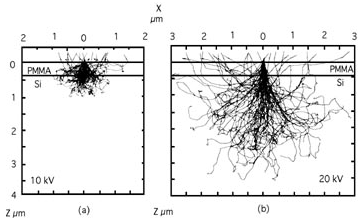 Someone has probably already heard that Rosnano at the end of 2012 invested in the mapper Lithography equipment development company. What and how they do, if it will save the domestic microelectronic industry - we find out in this article.
Someone has probably already heard that Rosnano at the end of 2012 invested in the mapper Lithography equipment development company. What and how they do, if it will save the domestic microelectronic industry - we find out in this article.As we remember , the production of microcircuits involves the sequential processing of a semiconductor wafer through an exposed photoresist layer, the image on which is usually formed optically: a “scanner” projects a photomask image through a reducing lens.
This approach has a number of drawbacks: the need to make photo masks for each new chip (omitting the possibility of group production here) leads to the fact that products must be large-scale, millions of pieces, to recoup the cost of photo masks (up to several million $ for each type of chip). And on the other hand, the wavelength of light limits the minimum size of the elements to be drawn. Now the global industry has come close to the theoretical resolution limit of optical lithography: ~ 35nm for NA = 1.35 scanners with ArF lasers at a wavelength of 193nm and ~ 18nm for lithography on a hard ultraviolet EUV (however, it is not yet used in mass production).
')
There is an alternative: to expose the photoresist not with light, but with an electron beam - electron lithography is obtained. The electron beam can be focused to a much smaller point, even 1nm is not a problem, but new problems also appear.
The photo shows a simulation of the electron hitting the electronresist, demonstrating the problem with the resolution of the electronresist due to electron scattering.
Limitations of Electron Lithography
ExpositionIn order to "light up" the electron-resist - a certain number of electrons must be per unit of area. For typical good electron-resists - the exposure is about 30 microculls per square centimeter. This means that one beam with a current of 10nA (10 nanocolons per second) will illuminate a 300mm plate with an area of 706 cm 2 for 706 * 30 / (10 * 0.001) = 24 days. And this despite the fact that such exposures on the plate need a few. This was one of the significant factors limiting the spread of electron lithography (such a single-beam system is no more complicated than a scanning electron microscope - and they were already sold in 1965).
Can it be possible to increase the current in the beam?
Beam current
Two problems appear here: as we remember, identical charges repel each other. Accordingly, electrons in flight "push" each other and make the beam wider. The more current (= more electrons in flight) - the more this effect is manifested. Accordingly, it is not possible to significantly increase the current without degrading the resolution.
And finally, a beam with a relatively large current instead of exposing an electron resist - can fry / evaporate it (as in electron beam welding).
Electric resist
One of the remaining problems is that electrons do not just expose an electron resist when hit, but gradually lose energy, moving in its thickness by accidentally changing direction. Partly you can fight this effect by reducing the energy of electrons (= speed) - but this makes it necessary to reduce the current, so that the electrons do not begin to “push” each other in flight. The mapper uses energy of 5 kV, respectively, the volume in which electrons are scattered is much smaller than that shown in the first photo in the article.
The principle of operation of a multipath system
For comparison, the Mapper system is on the left, on the right is the classic single beam electron microscope.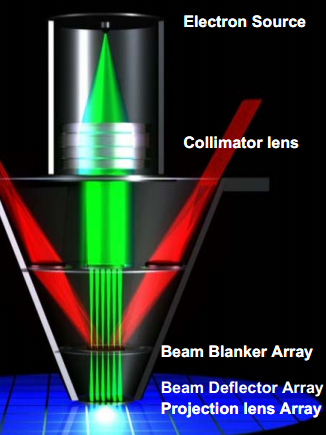
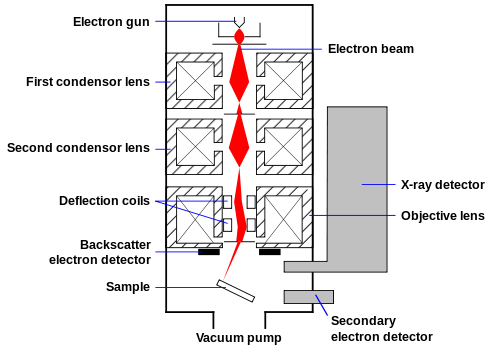
In the classical system (right) - the beam from the electron gun (above) is focused by electrostatic lenses and deflected to the right place by deflecting coils or electrostatic deflectors. Directly to scale such a system would be costly - it would be necessary to duplicate all the structural elements.
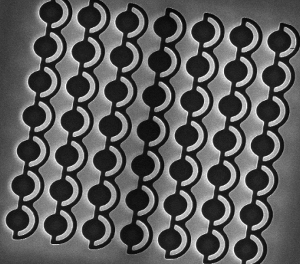 The Mapper has one powerful source of electrons, a collimator (an electrostatic lens, focusing them so that a broad parallel electron beam is obtained). Then this wide beam hits the blocker matrix (in the photo on the right) —in fact, there is a plate with holes, at one of the walls of which is a deflecting electrode. When voltage is applied to the electrode, the electrons are deflected and do not get further anywhere. If there is no current, then with a parallel beam and fly farther. In the prototype of the system, the number of rays was 7x7, now they are making a “combat” system with 13 thousand rays (in fact, just more “holes” and connections to them, that's all).
The Mapper has one powerful source of electrons, a collimator (an electrostatic lens, focusing them so that a broad parallel electron beam is obtained). Then this wide beam hits the blocker matrix (in the photo on the right) —in fact, there is a plate with holes, at one of the walls of which is a deflecting electrode. When voltage is applied to the electrode, the electrons are deflected and do not get further anywhere. If there is no current, then with a parallel beam and fly farther. In the prototype of the system, the number of rays was 7x7, now they are making a “combat” system with 13 thousand rays (in fact, just more “holes” and connections to them, that's all).Initially (~ 2008) Mapper wanted to control these deflection electrodes with the help of a laser, apparently so that the conductors did not distort the “non-own” channels.
Since even 13,000 rays are not enough to cover a 26mm wide strip from a single pass — below are individual deflectors that can deflect each beam by about 2 micrometers along one axis (perpendicular to the plate movement). And finally - for each beam its own electrostatic lens for focusing.
As a result, such a system is much easier to scale - all these microplates with “holes” are made according to the already developed MEMS technical processes at serial plants, and if necessary they can be scaled further. Electronic optics are maximally simplified (= cheaper) - due to the fact that each beam needs to be deflected at a very small distance (2 microns), and even along one axis. Judging by the presentations, the future plans include the integration of CMOS control logic into the MEMS devices, which should further expand the scalability of the system.
The exposure of the entire plate is ensured by the synchronous smooth movement of the plate itself relative to the installation. This method has long been used in serial optical scanners - so all the problems have already been solved.
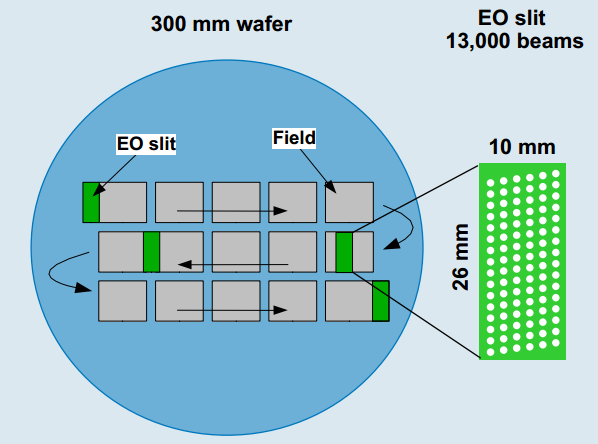
Results and summary
The prototype of the Mapper works, they want to achieve a resolution of 16nm (with an arbitrary geometry, optical lithography on a 193nm laser in such conditions produces at least 35-40nm). At the beginning of 2014, the first launches of the new system with 13 thousand rays were planned. In serial production should go in 2015-2016. However, there is also a fly in the ointment: immediately after receiving money from Rosnano at the end of 2012, there was no other news on the company's website. I wrote to them 2 times on this topic - they are silent like a fish on ice.When investing, Rosnano obliged the company to transfer part of the production to the Russian Federation, and it was planned to transfer just micro-optics. Whether this is done or not at the moment is not known, it is written on the Rosnano website that something is happening in the technopolis “Moscow” .
At the cost of the final device, the manufacturer is oriented at a cost comparable to EUV scanners at the rate of 1 plate per hour (~ $ 500 thousand / wph). Since The maximum capacity of a Mapper in one installation is 10 plates per hour, to get the same ~ 100 plates per hour - the system is proposed to be installed in several copies.
When the system goes into mass production - you can expect a further reduction in cost, because There are no sore points of optical photolithography — a source of light (both EUV and ArF lasers cost a lot of money), a complex and monstrously expensive lens and photo masks that need to be made for each new type of microcircuit. And the electronic microoptics - is mass-produced at least in a million copies without problems.
The emergence of such systems - promises to also reduce the cost of small-scale chips, there will be an alternative to FPGA with much greater performance.
Such systems are especially popular with the military and fit perfectly into the current Russian concept of “small microelectronic dual-use production”. However, it’s too early to rejoice - Rosnano is only one of the investors and the manufacturer will in any case be forced to comply with the export control requirements of all countries involved in the development. And this means that it will be possible to get such a system in Russia for good only for civilian production, and it is with them (or rather, their absence) that we have a problem - I will write more about that later.
Links
2008: MAPPER: High Throughput Maskless Lithography
2010: MAPPER: High Throughput Maskless lithography
2010, SPIE: MAPPER: High Throughput Maskless lithography
2012: RUSNANO invests in maskless lithography with resolution up to 10 nm
2013: Lithography Cost-Effective Solutions for 1X nodes
Source: https://habr.com/ru/post/213379/
All Articles